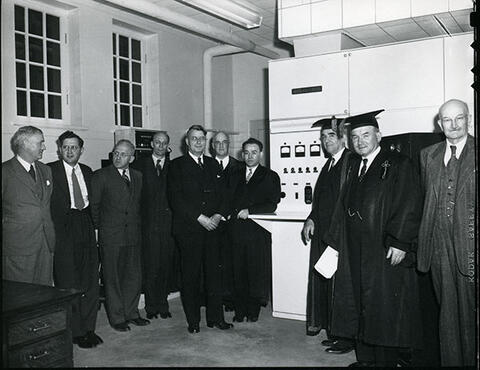
Área de título y declaración de responsabilidad
Título apropiado
Betatron - Ceremony
Tipo general de material
- Graphic material
Título paralelo
Otra información de título
Título declaración de responsabilidad
Título notas
Nivel de descripción
Item
Institución archivística
Código de referencia
Área de edición
Declaración de edición
Declaración de responsabilidad de edición
Área de detalles específicos de la clase de material
Mención de la escala (cartográfica)
Mención de proyección (cartográfica)
Mención de coordenadas (cartográfica)
Mención de la escala (arquitectónica)
Jurisdicción de emisión y denominación (filatélico)
Área de fechas de creación
Fecha(s)
-
1948 (Criação)
Área de descripción física
Descripción física
1 photograph : b&w ; 12.5 x 17.5 cm
Área de series editoriales
Título apropiado de las series del editor
Títulos paralelos de serie editorial
Otra información de título de las series editoriales
Declaración de responsabilidad relativa a las series editoriales
Numeración dentro de la serie editorial
Nota en las series editoriales
Área de descripción del archivo
Nombre del productor
Historial de custodia
Alcance y contenido
Faculty, including Dr. Harold E. Johns, standing around the newly acquired betatron equipment.
Bio/Historical Note: In May 1948 Dr. Harold E. Johns, Dr. Newton Haslam, and Dr. Leon Katz, professors of Physics at the University of Saskatchewan, travelled to Milwaukee to inspect the betatron that had been built for the U of S. In August of that same year, the U of S installed in the Physics Annex the first betatron in Canada—the world’s first betatron used for a cancer treatment program. Dr. Johns then began the design and construction of one of the first cobalt-60 teletherapy units. Dr. Johns and his graduate students became the first researchers in the world to successfully treat a cancer patient using cobalt-60 radiation therapy. It was also used for research programs in nuclear physics, radiation chemistry, cancer therapy and radiation biology. In 1951 the world’s first calibrated Cobalt-60 cancer therapy unit was installed at University Hospital (G Wing). The calibration work was done by Dr. Sylvia Fedoruk through rigorous depth dose measurements. In early 1952, Maclean's magazine had dubbed the cobalt-source radiotherapy machine the cobalt bomb - a tongue-in-cheek tribute to this peaceful use of nuclear technology. Dr. Johns’ pioneering work in cobalt-60 teletherapy became the gold standard for radiation therapy for many years and thousands of units were installed worldwide, helping countless patients. The original treatment device was used in Saskatchewan until 1972. The work Dr. Johns and his team did on the physics of high energy photon beams was fundamental, and still forms the basis of most treatment planning systems in use today.
Área de notas
Condiciones físicas
Origen del ingreso
Arreglo
Idioma del material
Escritura del material
Ubicación de los originales
Disponibilidad de otros formatos
Restricciones de acceso
Condiciones de uso, reproducción, y publicación
Photographer: Unknown
Copyright holder: Public domain
Other terms: Responsibility regarding questions of copyright that may arise in the use of any images is assumed by the researcher.

